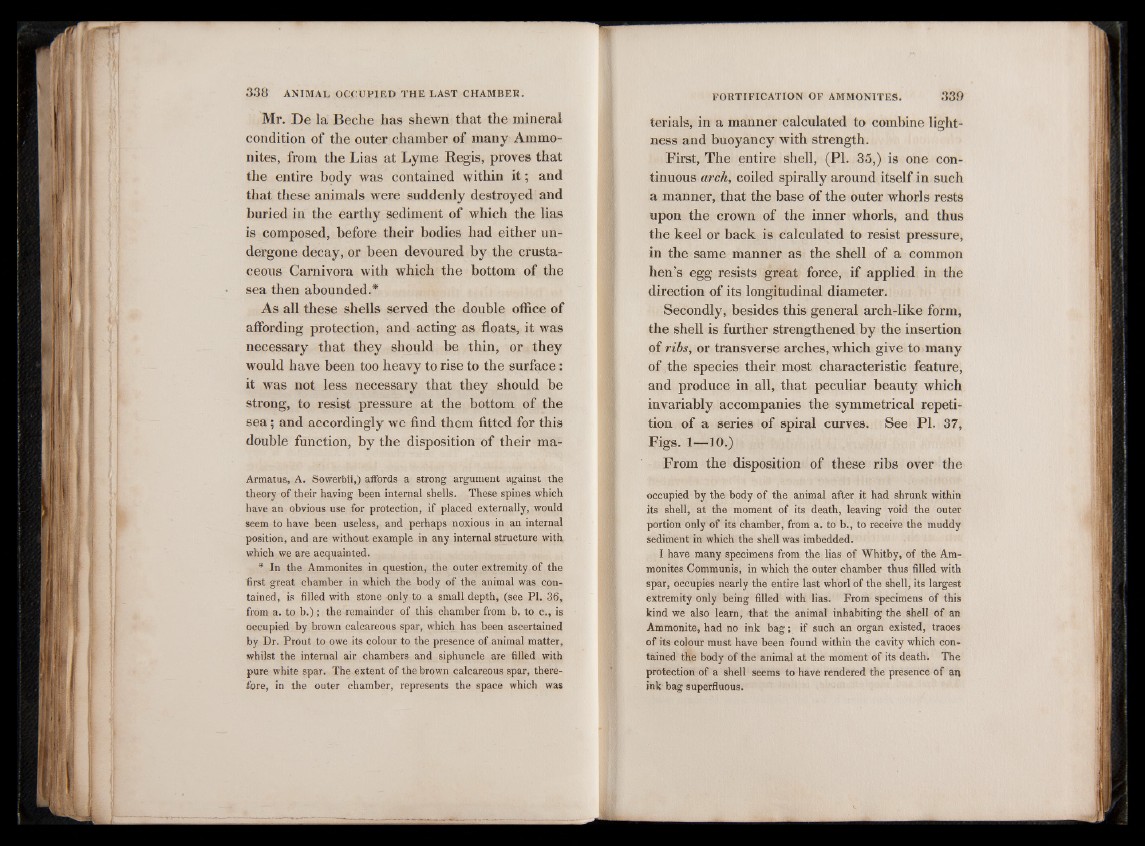
Mr. De la Beche has shewn that the mineral
condition of the outer chamber of many Ammonites,
from the Lias at Lyme Regis, proves that
the entire body was contained within i t ; and
that these animals were suddenly destroyed and
buried in the earthy sediment of which the lias
is composed, before their bodies had either undergone
decay, or been devoured by the crusta-
ceous Carnivora with which the bottom of the
sea then abounded.*
As all these shells served the double office of
affording protection, and acting as floats, it was
necessary that they should be thin, or they
would have been too heavy to rise to the surface:
it was not less necessary that they should be
strong, to resist pressure at the bottom of the
sea; and accordingly we find them fitted for this
double function, by the disposition of their ma-
Armatus, A. Sowerbii,) affords a strong argument against the
theory of their having been internal shells. These spines which
have an obvious use for protection, if placed externally, would
seem to have been useless, and perhaps noxious in an internal
position, and are without example in any internal structure with
which we are acquainted.
* In the Ammonites in question, the outer extremity of the
first great chamber in which the body of the animal was contained,
is filled with stone only to a small depth, (see PI. 36,
from a. to b.) ; the remainder of this chamber from b. to c., is
occupied by brown calcareous spar, which has been ascertained
by Dr. Prout to owe its colour to the presence of animal matter,
whilst the internal air chambers and siphuncle are filled with
pure white spar. The extent of the brown calcareous spar, therefore,
in the outer chamber, represents the space which was
terials, in a manner calculated to combine lightness
and buoyancy with strength.
First, The entire shell, (PI. 35,) is one continuous
arch, coiled spirally around itself in such
a manner, that the base of the outer whorls rests
upon the crown of the inner whorls, and thus
the keel or back is calculated to resist pressure,
in the same manner as the shell of a common
hen’s egg resists great force, if applied in the
direction of its longitudinal diameter.
Secondly, besides this general arch-like form,
the shell is further strengthened by the insertion
of ribs, or transverse arches, which give to many
of the species their most characteristic feature,
and produce in all, that peculiar beauty which
invariably accompanies the symmetrical repetition
of a series of spiral curves. See PI. 37,
Figs. 1— 10 .)
From the disposition of these ribs over the
occupied by the body of the animal after it had shrunk within
its shell, at the moment of its death, leaving void the outer
portion only of its chamber, from a. to b., to receive the muddy
sediment in which the shell was imbedded.
I have many specimens from the lias of Whitby, of the Ammonites
Communis, in which the outer chamber thus filled with
spar, occupies nearly the entire last whorl of the shell, its largest
extremity only being filled with lias. From specimens of this
kind we also learn, that the animal inhabiting the shell of an
Ammonite, had no ink bag; if such an organ existed, traces
of its colour must have been found within the cavity which contained
the body of the animal at the moment of its death. The
protection of a shell seems to have rendered the presence of an
ink bag superfluous.